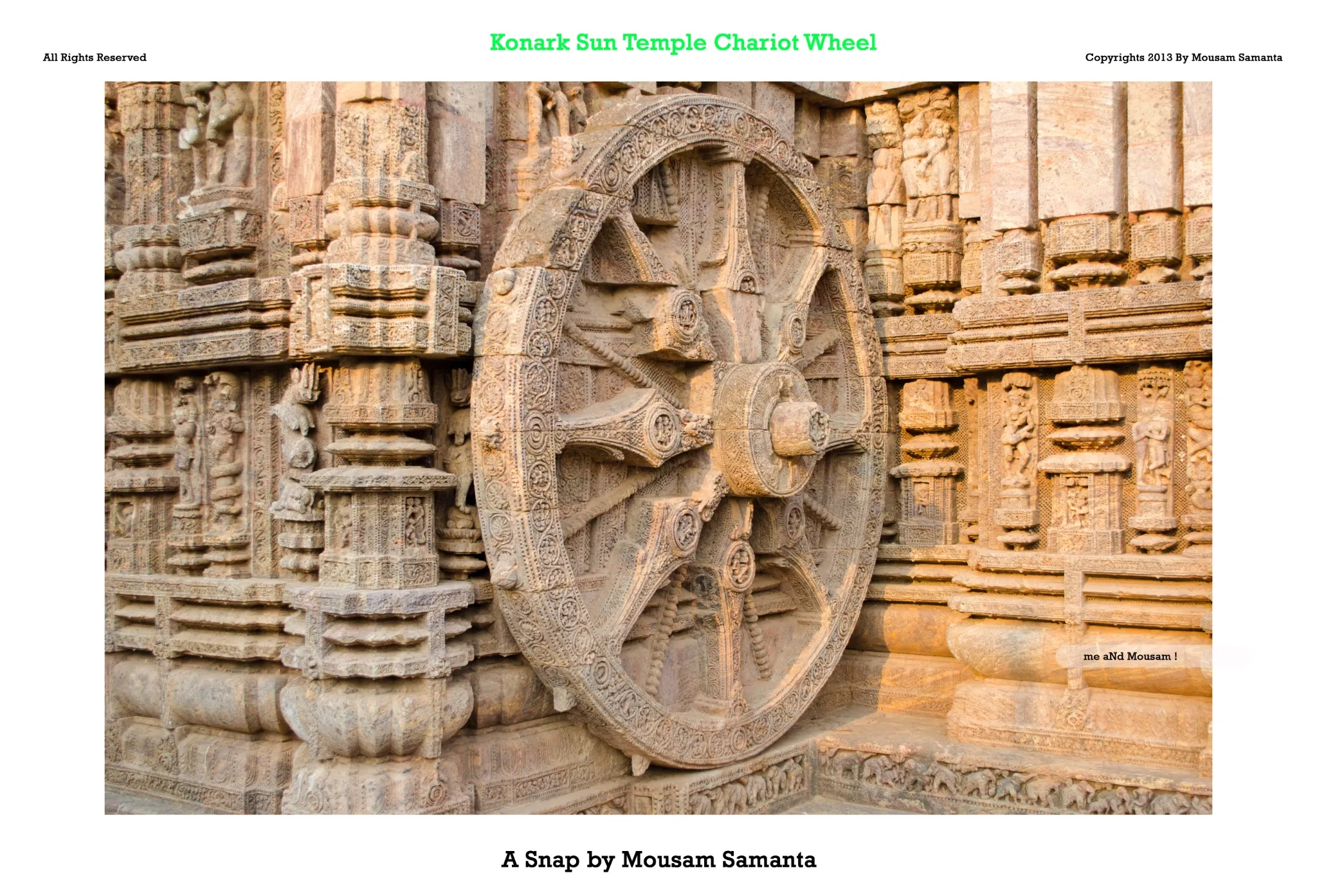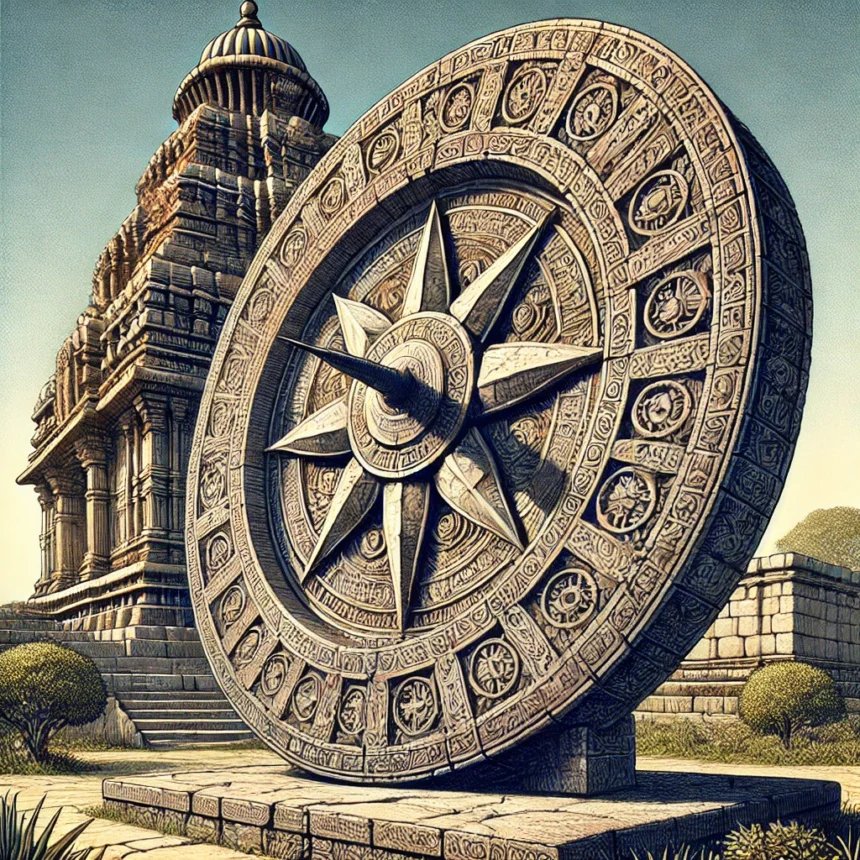Vedic Maths Implementation in Sundial at Konark Sun Temple
A Vedic Maths Marvel at The Sundial at Konark Sun Temple
Following our exploration of the Vedic science behind the iconic Sun Temple of Konark in our previous blog post, we delve deeper into another fascinating aspect of this architectural wonder: its sundial. Scheduled for publication on June 9, 2024, as part of HinduInfoPedia.org’s Sunday series “Reflections and Personal Insights,” this post continues our series on the multifaceted dimensions of the Sun Temple. Known as the “Black Pagoda,” this 13th-century marvel, erected under King Narasimhadeva I of the Eastern Ganga Dynasty, not only embodies spiritual sanctity but also demonstrates the advanced scientific and mathematical knowledge of its era.
In this installment, we focus on the temple’s sundial, an exemplary manifestation of Vedic maths. This feature of the temple is not just an artistic embellishment but a sophisticated timekeeping tool that aligns celestial and terrestrial realities. By examining the sundial, we uncover how ancient builders harmonized architectural genius with mathematical precision, embedding complex calculations directly into the temple’s structure. Join us as we explore how these ancient mathematical principles continue to offer insights into the architectural prowess and scientific acumen of Vedic culture.
Introduction to Vedic Maths
Vedic maths is an ancient Indian mathematical system derived from the Vedas—sacred texts that form the foundation of Hindu spiritual and scientific discourse. This system is renowned for its unique collection of sutras or aphorisms, which simplify arithmetic, algebraic operations, and complex calculations. It emphasizes mental calculation techniques that enhance computational speed and accuracy, qualities that have ensured its relevance in both contemporary education and professional disciplines.
This traditional form of maths is not merely a historical artifact; it remains vitally relevant today. Its methods are employed across various fields—from computing to cryptography—demonstrating the adaptability and enduring utility of these techniques. Vedic maths simplifies the numerical complexities faced in different scientific and engineering applications, making it a valuable educational tool that fosters a quicker, more intuitive approach to maths.
Moreover, the principles of Vedic maths were not confined to theoretical explorations; they were practically applied in ancient India’s architectural and astronomical achievements, as vividly illustrated by the sundial at the Konark Sun Temple. This application underscores the system’s broad utility, bridging simple arithmetic to complex architectural design, thereby weaving together an impressive legacy of both cultural heritage and scientific advancement.
The Sundial at Konark Sun Temple

[Image Credit https://flickr.com]
The sundial at the Konark Sun Temple serves as a striking illustration of Vedic maths applied within architectural design. This temple, shaped like a massive chariot, features twelve pairs of intricately carved stone wheels. Each wheel represents one of the twelve months of the year, integrating time into the very structure of the temple, which transcends mere aesthetic value to embrace a functional role in marking the passage of time.
Mathematical Precision in Design
The design of each wheel is not random but is imbued with deep mathematical significance. Every wheel contains eight spokes, each representing one of the eight praharas, or three-hour periods, that divide the day. This division by spokes isn’t just symbolic; it plays a crucial role in the sundial’s ability to measure time with astonishing precision. As the sun progresses across the sky, the shadows cast by these spokes shift, marking time in minute intervals, allowing observers to follow the day’s progression with reliable accuracy.
The positioning and carving of these wheels are not left to chance but are the result of rigorous mathematical planning. The alignment of each wheel has been carefully calculated to match the geographical coordinates of Konark. This precision involves sophisticated knowledge of spherical geometry and trigonometry—key components of Vedic maths. These mathematical disciplines were harnessed by the temple’s architects to ensure that the angles at which the wheels and spokes were set would allow the sundial to track time correctly across all seasons of the year. The careful consideration of the Earth’s curvature and its axial tilt reflects an advanced understanding of the principles governing celestial mechanics, embedded deeply in the temple’s design.
Through these features, the sundial at the Konark Sun Temple not only fulfills its primary function as a timekeeper but also stands as a testament to the advanced mathematical and astronomical knowledge possessed by the creators of this historical monument. This integration of functional architecture with precise mathematical principles allows the sundial to remain a powerful symbol of the scientific prowess underlying ancient Vedic culture.
Geometry and Trigonometry in Vedic Maths
Vedic maths encompasses a wealth of knowledge in geometrical and trigonometric concepts, both of which are vividly demonstrated in the construction of the sundial at Konark Sun Temple. This architectural feature, more than just a timekeeper, serves as a testament to the precise mathematical applications derived from ancient Vedic teachings.
The design of the sundial’s wheel, divided into eight equal sections, exemplifies the application of Vedic geometry. This division is not merely for aesthetic symmetry but plays a critical role in the functionality of the sundial. Each segment corresponds to a three-hour period, or prahara, of the day, requiring exactitude in the measurement and division of the circle to ensure the sundial’s accuracy throughout the day. The process involves calculating the circumference and diameter of the wheel to achieve perfect segmentation, demonstrating a sophisticated understanding of geometric principles.
Furthermore, the orientation of the temple itself is a brilliant use of trigonometric calculations. The entire structure is aligned precisely towards the east, the direction from which the sun rises. This strategic orientation is critical for the sundial’s functionality, especially during significant astronomical events such as the solstices and equinoxes. On these days, the sun’s position at dawn and dusk is crucial for marking the longest and shortest days of the year. The alignment of the temple utilizes trigonometric principles to calculate the exact angle of the sun’s rays as they strike the temple, ensuring that the sundial accurately reflects these important celestial moments.
This careful alignment not only allows the sundial to function accurately but also showcases the advanced understanding of celestial mechanics by Vedic mathematicians. Their ability to integrate these mathematical principles into the temple’s construction demonstrates a profound mastery over both geometry and trigonometry, reflecting their deep engagement with the cosmos and their dedication to embedding this knowledge within cultural and religious monuments. Through these mathematical applications, the sundial at Konark remains a profound illustration of how ancient civilizations used Vedic maths to bridge the gap between the earthly and the astronomical.
Challenges for Modern Science in Deciphering Ancient Sundial Designs
Despite the advances in modern science and technology, fully understanding and replicating the design systems of ancient sundials, such as the one at Konark Sun Temple, poses significant challenges. The intricacies of these ancient engineering feats often go beyond the mere application of contemporary mathematical and astronomical concepts, making them difficult for modern scientists to completely decode.
Loss of Contextual Knowledge
One of the primary hurdles is the loss of contextual and cultural knowledge. The architects of the Konark Sun Temple, and similar structures, operated within a specific cultural and philosophical framework that influenced their scientific and mathematical applications. Much of this ancient knowledge was transmitted orally or through manuscripts that have either perished, remain untranslated, or are difficult to interpret without a deep understanding of the historical and cultural context in which they were written. Modern science often struggles with this gap, as the underlying principles that guided ancient technologies are not fully documented in ways contemporary researchers can easily access or understand.
Differences in Measurement Systems
Additionally, the measurement systems used in ancient times differ significantly from today’s standardized metrics. Ancient units of measurement were often based on local or regional norms, which may relate to the human body, local geography, or the movements of celestial bodies, and these units are not always easily convertible into modern measurements. This discrepancy makes it challenging to accurately replicate or understand the precision with which ancient structures were built.
Advanced Yet Unrecognized Technologies
Furthermore, there is a growing realization that ancient civilizations may have used advanced technologies or mathematical principles that have not been continuously developed or that have been lost to time. For instance, the precise alignment and the specific geometric proportions used in the Konark Sun Temple suggest a sophisticated understanding of optics and shadow play, aspects that modern science has not fully explored in the context of ancient architectural design.
Integration of Multiple Disciplines
Finally, ancient constructions like the Konark Sun Temple often integrate multiple disciplines—astronomy, geometry, religious symbolism, and local mythology—which are deeply interwoven into the fabric of the structure. Modern scientific approaches tend to compartmentalize these disciplines, which can lead to a fragmented understanding of how these structures functioned as cohesive wholes. The holistic approach taken by ancient builders, where architecture served multiple social, religious, and practical purposes simultaneously, requires a multidisciplinary study approach that is often challenging to coordinate in modern research frameworks.
In conclusion, while modern science has made significant strides in many areas, the full comprehension of ancient systems like the sundial design at Konark requires not only technological expertise but also an in-depth appreciation of the historical, cultural, and philosophical milieu that produced these marvels. Bridging this gap remains one of the intriguing challenges in the study of ancient scientific achievements.
The Legacy of Vedic Maths
The sundial at the Konark Sun Temple symbolizes more than just a historical relic; it embodies the enduring legacy of Vedic maths. The precision and sophistication in its design reflect the advanced mathematical and scientific knowledge achieved by ancient Indian scholars. This knowledge is embedded within every aspect of the sundial, from its geometric accuracy to its astronomical alignment, showcasing a deep integration of science and spirituality.
In contemporary times, Vedic maths is recognized not just for its historical significance but for its practical applications. It offers streamlined methods for arithmetic and algebra, facilitating faster mental calculations and promoting a more intuitive understanding of mathematical concepts. This makes Vedic maths a valuable tool in educational curricula worldwide, enhancing students’ numeracy skills and cognitive abilities.
Moreover, the principles of Vedic maths, illustrated by the meticulous design of the Konark Sun Temple’s sundial, continue to inspire mathematicians and scientists. By studying these ancient techniques, modern scholars can gain insights into alternative mathematical methodologies and their potential applications in technology, engineering, and beyond.
In conclusion, as we explore and rediscover the complexities of Vedic maths, the Konark Sun Temple’s sundial stands as a testament to the ingenuity of ancient civilizations and their profound contributions to the mathematical world. Its legacy continues to influence contemporary scientific thought and underscores the relevance of integrating historical wisdom with modern educational practices.
Reflections on Vedic Maths Impressions at Sundial
The sundial at the Konark Sun Temple stands as a testament to the ingenuity of our ancestors and their profound contributions to the mathematical world. As we continue to explore and appreciate Vedic maths, the precision and functionality of this ancient architectural feature exemplify the advanced scientific knowledge of ancient India. Our journey through the multifaceted dimensions of the Sun Temple reveals how Vedic maths was not only a theoretical discipline but a practical tool that enhanced daily and spiritual life. By incorporating these ancient techniques into modern educational practices, we can gain a deeper appreciation for the rich heritage of Indian science and its enduring relevance in today’s world. This series at HinduInfoPedia.org aims to illuminate the seamless integration of art, science, and spirituality in Vedic culture, showcasing how ancient wisdom can inform and enrich our contemporary understanding of the universe.
Feature Image: Click here to view the image.
#VedicMathematics #KonarkSunTemple #AncientArchitecture #SundialDesign #AstronomicalEngineering
Related Posts



Leave a Reply